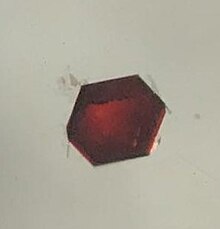
| |

| |
| Names | |
|---|---|
| IUPAC name
Bis(η8-cyclooctatetraenyl)plutonium(IV)
| |
| Other names
Plutonium cyclooctatetraenide
Pu(COT)2 | |
| Identifiers | |
3D model (JSmol)
|
|
| |
| |
| Properties | |
| C16H16Pu | |
| Molar mass | 452 g·mol−1 |
| Appearance | cherry red crystals |
| insoluble, does not react with water | |
| Solubility in chlorocarbons | sparingly soluble (ca. 0.5 g/L) |
| Hazards | |
| Occupational safety and health (OHS/OSH): | |
Main hazards
|
radiation hazard, pyrophoric, toxic |
Except where otherwise noted, data are given for materials in their standard state (at 25 °C [77 °F], 100 kPa).
| |
Plutonocene, Pu(C8H8)2, is an organoplutonium compound composed of a plutonium atom sandwiched between two cyclooctatetraenide (COT2-) rings. It is a dark red, very air-sensitive solid that is sparingly soluble in toluene and chlorocarbons.[1][2] Plutonocene is a member of the actinocene family of metallocenes incorporating actinide elements in the +4 oxidation state.
Compared to other actinocenes such as uranocene, plutonocene has been studied to a lesser degree since the 1980s due to the notable radiation hazard posed by the compound.[3][4] Instead, it has mostly been the subject of theoretical studies relating to the bonding in the molecule.[4][5]
Structure and bonding[edit]
The compound has been structurally characterised by single crystal XRD.[3][4] The cyclooctatetraenide rings are eclipsed and assume a planar conformation with 8 equivalent C–C bonds of 1.41 Å length; the molecule possesses a centre of inversion at the position occupied by the plutonium atom.[3][4] The Pu–COT distance (to the ring centroid) is 1.90 Å and the individual Pu–C distances are in the 2.63–2.64 Å range.[3]
Despite the similarity in molecular structures, plutonocene crystals are not isomorphous to other actinocenes, as plutonocene crystallises in the monoclinic I2/m space group whereas thorocene, protactinocene, uranocene and neptunocene all crystallise as monoclinic P21/n.[3]
Theoretical calculations utilising various computational chemistry methods support the existence of an enhanced covalent character in plutonocene from the interaction of Pu 6d and 5f atomic orbitals with ligand-based π orbitals.[2][4][5]
Synthesis[edit]
Plutonocene was first synthesized in 1970 form the reaction of tetraethylammonium hexachloroplutonate(IV) ([N(C2H5)4]2PuCl6) with dipotassium cyclooctatetraenide (K2(C8H8)) in THF at room temperature:[1][2]
- (NEt4)2PuCl6 + 2 K2(C8H8) → Pu(C8H8)2 + 2 NEt4Cl + 4 KCl
This approach is different compared to the synthesis of other actinocenes which usually involves the reaction of the actinide tetrachloride AnCl4 with K2(C8H8); this is not possible in the case of plutonium, as no stable plutonium(IV) chloride species is known.[4] The reaction also does not work when using the caesium or pyridinium hexachloroplutonate(IV) salts in the place of the tetraethylammonium one.[1]
A more recent synthesis involves 1 e− oxidation of the green [K(crypt)][PuIII(C8H8)2] salt with AgI:[3]
- [PuIII(C8H8)2]− + AgI → Pu(C8H8)2 + Ag0 + I−
The [PuIII(C8H8)2]− anion is obtained via ligand substitution from K2(C8H8) and other organoplutonium(III) complexes, which can be ultimately derived from reduction of the more common PuO2 with HBr in THF.[3] PuIII halides PuCl3 and PuI3 have also been used as the plutonium starting material.[3][4]
Other properties[edit]
The product is chemically analogous to uranocene and neptunocene, and they practically exhibit identical chemical reactivity. All three compounds are insensitive to water or dilute aqueous base, but are air-sensitive and react quickly to form oxides.[1][2][3] They are only slightly soluble (with saturation concentrations of about 10−3 M) in aromatic or chlorinated solvents such as benzene, toluene, carbon tetrachloride or chloroform.[1][2]
References[edit]
- ^ a b c d e Karraker, David G.; Stone, John Austin; Jones, Erwin Rudolph; Edelstein, Norman (1970-08-01). "Bis(cyclooctatetraenyl)neptunium(IV) and bis(cyclooctatetraenyl)plutonium(IV)". Journal of the American Chemical Society. 92 (16): 4841–4845. doi:10.1021/ja00719a014. ISSN 0002-7863.
- ^ a b c d e Greenwood, Norman N.; Earnshaw, Alan (1997). Chemistry of the Elements (2nd ed.). Boston, Mass.: Butterworth-Heinemann. pp. 1278–1280. ISBN 978-0-08-037941-8.
- ^ a b c d e f g h i Windorff, Cory J.; Sperling, Joseph M.; Albrecht-Schönzart, Thomas E.; Bai, Zhuanling; Evans, William J.; Gaiser, Alyssa N.; Gaunt, Andrew J.; Goodwin, Conrad A. P.; Hobart, David E.; Huffman, Zachary K.; Huh, Daniel N. (2020-09-21). "A Single Small-Scale Plutonium Redox Reaction System Yields Three Crystallographically-Characterizable Organoplutonium Complexes". Inorganic Chemistry. 59 (18): 13301–13314. doi:10.1021/acs.inorgchem.0c01671. ISSN 0020-1669. OSTI 1680020. PMID 32910649. S2CID 221623763.
- ^ a b c d e f g Apostolidis, Christos; Walter, Olaf; Vogt, Jochen; Liebing, Phil; Maron, Laurent; Edelmann, Frank T. (2017). "A Structurally Characterized Organometallic Plutonium(IV) Complex". Angewandte Chemie International Edition. 56 (18): 5066–5070. doi:10.1002/anie.201701858. ISSN 1521-3773. PMC 5485009. PMID 28371148.
- ^ a b Kerridge, Andrew (2013-11-06). "Oxidation state and covalency in f-element metallocenes (M = Ce, Th, Pu): a combined CASSCF and topological study". Dalton Transactions. 42 (46): 16428–16436. doi:10.1039/C3DT52279B. ISSN 1477-9234. PMID 24072035.